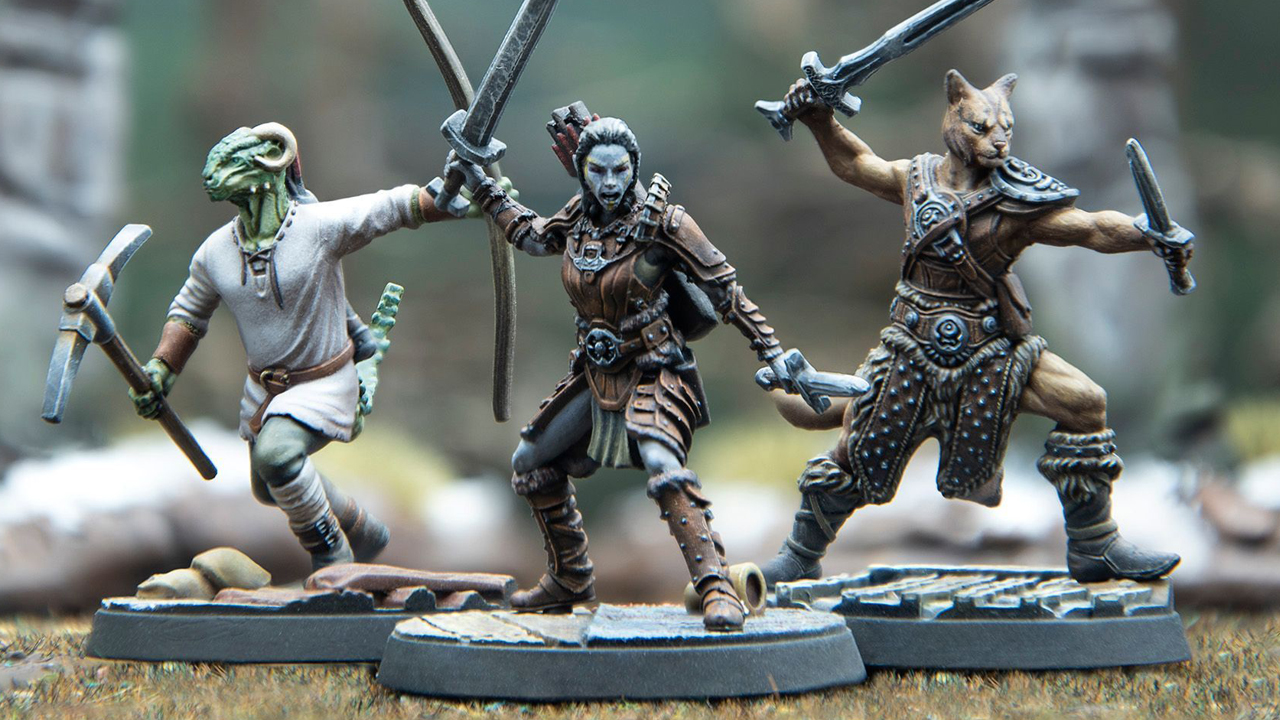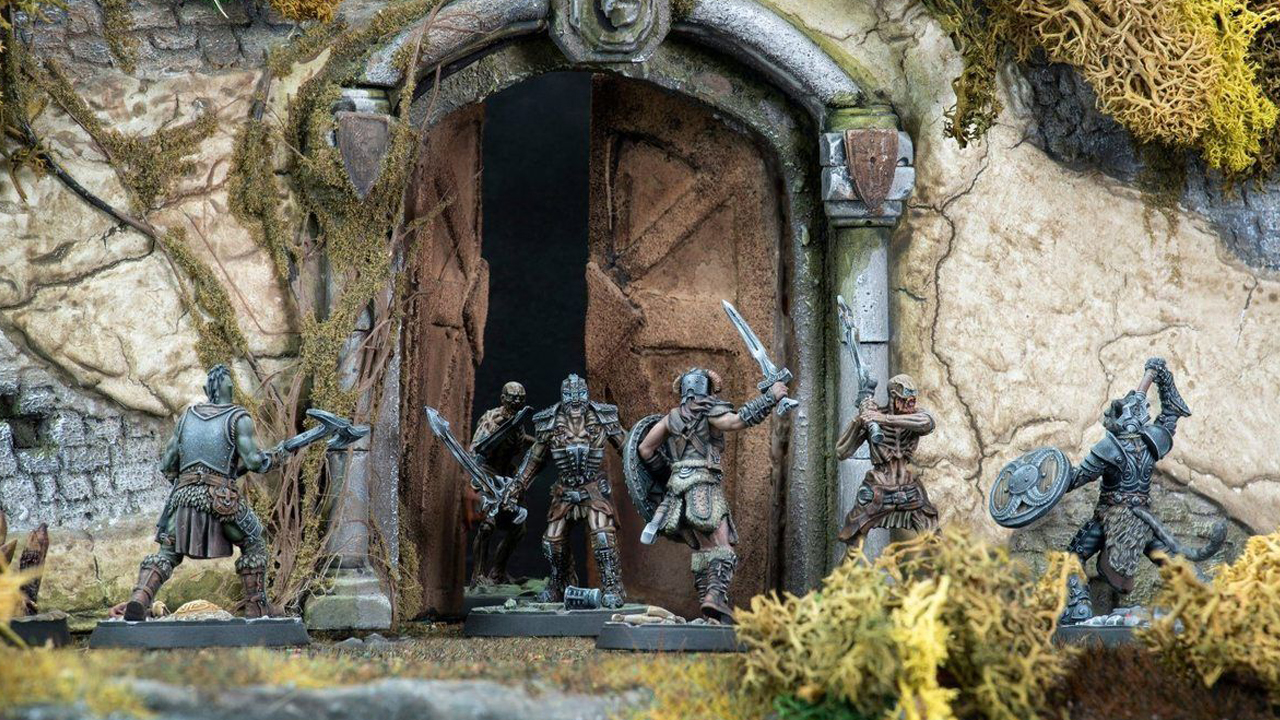GamesRadar+ Verdict
The tales you'll tell in The Elder Scrolls: Call to Arms are worth remembering.
Pros
- +
Focus on narrative
- +
Gorgeous miniatures
- +
Quick, snappy rules
Cons
- -
Can be overwhelming
- -
Not a lot of model variety right now
Why you can trust GamesRadar+

Genre: Tabletop wargame
Players: 1 - 2+
Difficulty: Moderate
Time to play: 60 - 120 mins
Set-up time: 5 - 10 mins
Ages: 14+
Developer: Modiphius Entertainment
I have perpetually bad luck in The Elder Scrolls: Call to Arms. No matter which mode I play or who I go up against, my 'heroic' mage always manages to poop the bed in the most spectacular way possible. But I don't care. The journey is a blast, and I'm left with plenty of water-cooler stories to last me until Elder Scrolls 6 finally breaks cover.
As a miniature wargame (think Warhammer), The Elder Scrolls: Call to Arms features models that you'll need to construct and paint yourself. And although it includes all the clashing swords and strategy you'd expect as a result, the game is more interested in a good narrative than anything else. This sets it apart from the competition in a big way. By adding elements from some of the best board games, Call to Arms offers a very different feel that we've not really seen before.
From screen to tabletop
Serving as a spiritual successor to Fallout: Wasteland Warfare, The Elder Scrolls: Call to Arms winds back the clock; it takes place during Skyrim's civil war we saw in the 2011 video game. This means our choice of armies include the Roman-esque Imperials and Stormcloak rebels, led by heroes from Skyrim's opening sequence that saw your character's execution gate-crashed by a dragon. And although no fire-breathers have made an appearance in miniature form yet, there are undead aplenty and adventurers of all stripes to choose from. Naturally, that includes the Dragonborn. Khajiit bandits and allies like Lydia are also available (even in model-form, it seems that she's still sworn to carry your burdens).
This 'greatest hits' approach is reflected in Call to Arms' mechanics. While the usual rolling of dice represents combat, heroes also get special cards with inventory slots (one for each hand), armor, stamina and magicka scores, upgradable stats, and more. Plus, there are items to collect on your adventures via treasure chest tokens that can then be equipped to improve your abilities. Even potions and poisons have snuck in there, allowing you to replenish your health or give your attacks some extra bite.
You've got time to soak all this in because of the snappy gameplay. While the rulebook itself is dense, The Elder Scrolls: Call to Arms doesn't rely on players memorising stats. Everything you need is written down on those reference cards, and they're easy to scan before returning to the game at hand. What's more, the success of a challenge - be it firing a bow or smacking someone in the head with an axe - is dictated by your character's score in the likes of strength and dexterity. This gives you a target number (as per the Dishonored roleplaying game), and all you have to do is roll less than that to succeed. Certain weapons add modifiers which lower the score further, and pips on separate dice tell you how much damage is done or if any special effects occur. It's a simple system that feels much more like a board game than I was expecting.

That's true of the various cardboard tokens, too. You get two sheets full of them in the Core Rules Box, and they include everything from spell icons to effects. Although matches can grind to a brief halt as you struggle to remember what some of them do - there are a lot to choose from - it's a cool idea that makes tracking your models' statuses much easier. The same can be said of items you'll gather over the course of the pre-written campaign; they'll make your heroes all the more powerful, offering a rare sense of progression that's not dissimilar to the best tabletop RPGs.
All this makes The Elder Scrolls: Call to Arms feel as close to its video game inspiration as possible. Whether it's through the font used on every card or the icons that have been chosen for tokens, it's like developer Modiphius has pulled code from the screen and made it real. There are even cheeky references to arrows in the knee and stolen sweetrolls. Meanwhile, the miniatures are superbly detailed; they perfectly capture their in-game counterparts. Yes, some are more difficult to put together than others (the skeletons and Dragonborn were a headache), but most are a satisfying project.
Dungeon delving
This isn't what sets it apart from other games like Warhammer 40,000 Indominus, though. That honor goes to its focus on storytelling. For starters, you'll draw an event card at the end of each round to shake up the battlefield through traps, quests that offer bonus points, and other effects to keep you on your toes. Similarly, you have the option to make fireside boasts or oaths before battle to net extra points at the end if you complete a certain objective (opening all the board's chests or defeating the enemy champion, for instance).
A non-player faction that exists purely to wreck shop helps The Elder Scrolls: Call to Arms stand out even more. Going head-to-head with a friend's army? Your efforts will be challenged by this bonus foe that makes its way across the battlefield like a force of nature. Known as 'Adversaries', their actions are decided by a card-based AI system. This revolves around three classes - warriors, sneaky rogues, and magic-users - who have a table of actions that tell you how the creature in question will respond when you roll a die. In addition, each model features a different set of characteristics that set it apart from the others. Warriors are more aggressive in general and will almost always move toward the foe, while archers mostly hang back and find cover to provide a better spot for sniping. This breathes new life into the tabletop wargaming experience.
It also offers exciting possibilities for solo play. Namely, there are adversary tables for each current unit in the game, including the Imperials and Stormcloaks. That means you can set up matches where all of your opponents are controlled by the AI cards.

That's where single-player 'Delves' make their grand entrance. This mode is a good old-fashioned dungeon crawl, and there are numerous missions within the game's quest book to play through. Each one is imaginative and unique, providing interesting challenges that range from defending a set of gates from oncoming foes to a treasure-hunt in the bowels of a Nordic tomb. Because each model and piece of equipment has a points value, the difficulty of the challenge ahead will also scale accordingly depending on who and what you bring with you.
Despite what the cynics among you may think, these missions are good fun. Their focus on narrative provides plenty to sink your teeth into even if you're playing alone, and the only downside is that you've got no one with which to share the stories you'll encounter. My Imperial wizard is always messing up, for example; their spells go wrong just when I need them most, making me suspect that I've ended up with village jokers rather than the hardened adventurers I was promised.
In fact, the main issue I have with Delve and the two-player Battle mode isn't mechanical. It would be a lack of models. Only a small handful of box-sets have been released so far, meaning there isn't a huge deal of variety to choose from. That'll change as time goes on, of course (the rulebook references factions that don't exist yet, and more kits are imminent), but it makes The Elder Scrolls: Call to Arms feel a little bare-bones at the time of writing.
Still, this sense of wanting more does give the impression that the best is yet to come. And for what it's worth, I genuinely think it is. With such a solid foundation in place, the next stage of The Elder Scrolls: Call to Arms should be special.

I've been writing about games in one form or another since 2012, and now manage GamesRadar+'s tabletop gaming and toy coverage. You'll find my grubby paws on everything from board game reviews to the latest Lego news.



